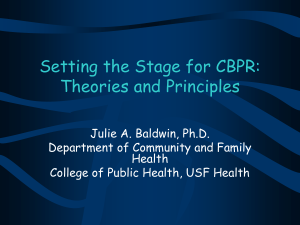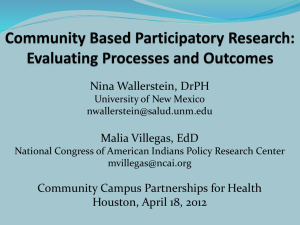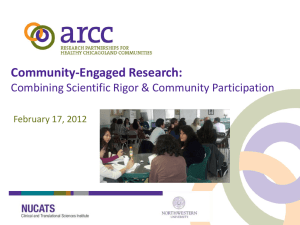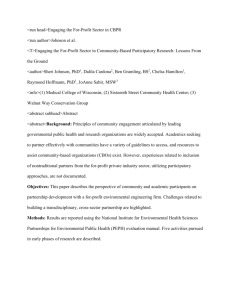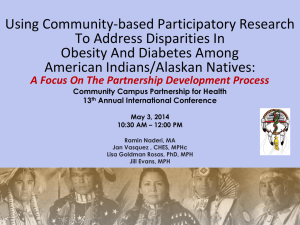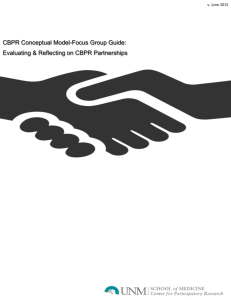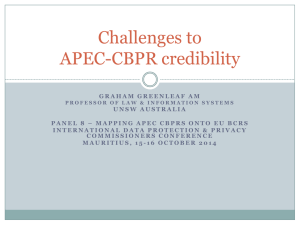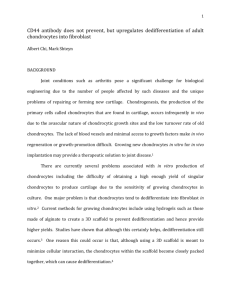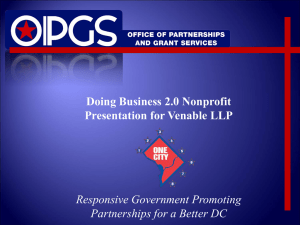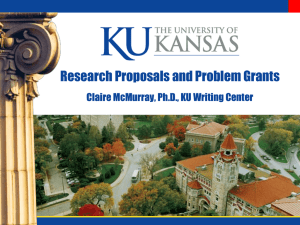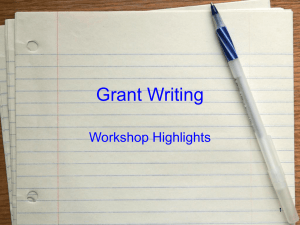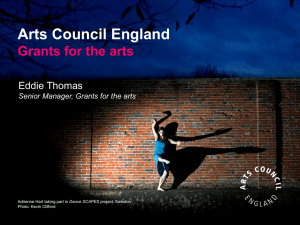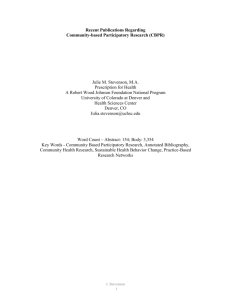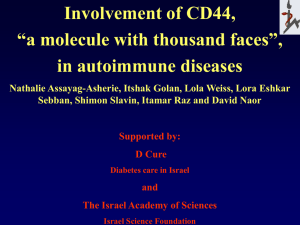Heaney-nuts-and-bolts-of-CBPR-2014-04-10
advertisement
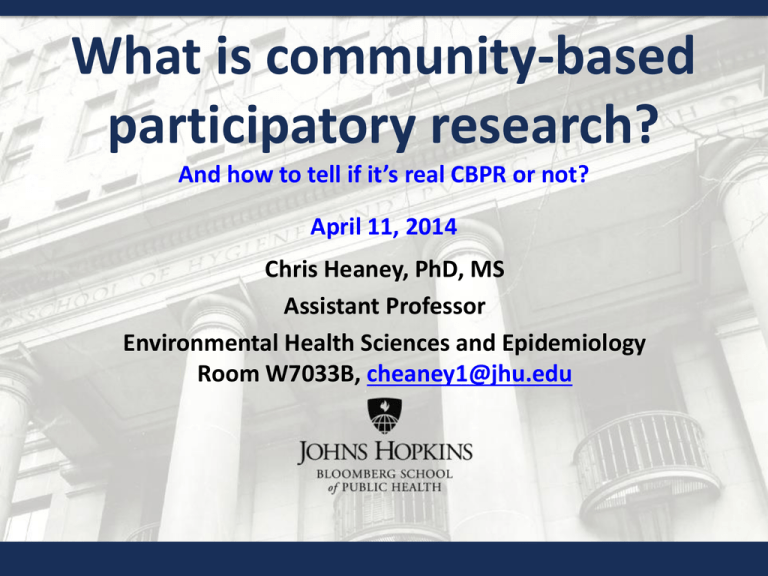
What is community-based participatory research? And how to tell if it’s real CBPR or not? April 11, 2014 Chris Heaney, PhD, MS Assistant Professor Environmental Health Sciences and Epidemiology Room W7033B, cheaney1@jhu.edu 2 Community-engaged research continuum There is a big difference between research performed... ON IN WITH populations/c ommunities populations/co mmunities populations/c ommunities Adapted from Nina Wallerstein, DrPH NM CARES Health Disparities Center, 2011 3 Forces at play along the communityengaged research continuum? http://www.stepupleader.com/response-able-leadership/ Power http://en.wikipedia.org/wiki/File:Fist.svg “…great power involves great responsibility.” Franklin D. Roosevelt 4 Gradations of partnership and collaboration DHHS. Principles of community-engagement. 2nd Ed. 2011. http://www.atsdr.cdc.gov/communityengagement/pdf/PCE_Report_508_FINAL.pdf Sherry R. Arnstein, Ladder of citizen participation. 1969. 5 Community-engaged research continuum Community-based /placed Community-based /placed No community input Some community input Univ. PIs, co-Is, staff Univ. PIs, co-Is, staff Community representative Community advisory board Community-based participatory research Univ. PIs, co-Is, staff Community co-Is, staff Community advisory board Community review board Community-driven research Community-PI, co-Is, staff Community review board Univ. co-Is, staff 6 Community-owned and managed research Community PIs, coIs, staff Community review board Community hires technical experts What is community-based participatory research (CBPR)? “A collaborative approach to research that equitably involves all partners in the research process and recognizes the unique strengths that each brings.” --W.K. Kellogg Foundation (2001) 7 Characteristics of CBPR 1. Collaborative, equitable partnership in all phases of research 2. Community is the unit of identity 3. CBPR builds on strengths and resources of community 4. CBPR fosters co-learning and capacity building 5. Balance between knowledge generation and benefit for community partners 8 Characteristics of CBPR (cont…) 6. CBPR focuses on problems of local relevance 7. CBPR disseminates results to all partners & involves all partners in wider dissemination 8. CBPR involves a long-term process and commitment to sustainability Israel, Eng, Schulz, & Parker (2005). Introduction to Methods in Community-Based Participatory Research for Health. In Methods in CommunityBased Participatory Research for Health. 9 What CBPR is NOT 1. “Community-placed/based” research 2. Sporadic or symbolic inclusion of communities 3. A specific method or research design 10 Present day context of CBPR • CBPR is inclusive of • CBPR is practiced in: participatory research – Public Health approaches with an – Medicine explicit social change – Psychology focus – Sociology • In social sciences may – Anthropology be referred to as – Urban Planning participatory research – Other disciplines or participatory action research 11 Why is CBPR relevant for clinical and translational research? • • • • Widening socioeconomic and health disparities Length of time to translate research into practice Difficulty in moving from efficacy to effectiveness Is researcher asking the wrong questions or looking in the wrong place? • Partnering with community can help with translation of data gathered into concrete changes: – – – – Public health Treatment Policy Practice 12 CBPR: Equitable, meaningful, active community participation in all phases of research Development of research questions Future research Discussing study design Who, where, why? Who is PI? Dissemination: Education, advocacy, policy change Delineating roles & responsibilities Who is supported? Does community organization take lead? Interpretation of results Drafting research proposal Iterative process Data analysis Does university take lead? Data collection, QA/QC, ongoing review Distribution of resources Refinement of study materials Participant recruitment, enrollment, retention 13 Successful CBPR strives to achieve… • Solutions for problems in accord with community priorities about concrete community concerns • Community capacity-building • Community empowerment • Local community ownership • Sustainable programs – beyond initial grant period • Radial changes – screening and/or therapeutic strategies, health outcomes, policies • Social justice • Environmental justice 14 Is this real CBPR or not? Where does this fall along the community-engagement continuum? While attending a conference to learn more about health topic X, an executive director of a local community-based organization (CBO) meets a university professor with expertise relevant to the community’s struggles to address health topic X. A week after the conference, the professor visits the community and meets with the executive director, CBO staff, and members of the community to learn more about the problem and discuss what the community sees as strategies to address health problem X. Several months go by until one day the executive director receives a call from the professor who says, “I have wonderful news, our Center just received a $5 million grant to study the problem we discussed in your community related to health topic X. To get started with the grant we would like you to help us identify a community representative to work with us on the project. For the period of the project we will pay the community representative a full-time salary and benefits. We would also like to get more information about your experiences with health problem X since we last spoke.” 15 Is this real CBPR or not? Where does this fall along the community-engagement continuum? A university research Center supports a community advisory board (CAB), consisting of one Center administrator and the leaders of several local community-based organizations (CBOs). CAB members serve for distinct terms and some have served multiple terms since the establishment of the Center. CAB members are paid as part-time university contractors for the time they commit to CAB activities. CAB members are consulted regularly about research directions of the Center and are asked to review a diverse number of research proposals to internal and external funding agencies. All proposals that the CAB reviews have PIs and Co-Is that are university faculty. Feedback provided by the CAB is used to make modifications to proposals before submission and the CAB is frequently listed as part of a proposal’s “Approach” section as an example of how the PI will seek iterative community input and involvement in the research project. Several successful grants have been funded through this process and some have resulted in sub-contracts to the CBOs of CAB members to assist with participant enrollment and data collection. For these sub-contracts, the CBO retains the decision-making power to hire community research assistants and staff to work full time with benefits for the CBO for the period of the grant’s sub-contract. 16 Is this real CBPR or not? Where does this fall along the community-engagement continuum? A university professor has served on the board of directors of a local community based organization (CBO) for one term. Her research interests overlap with the mission and vision of the CBO and at one of the regular board meetings she shares a request for proposals (RFP) for improving health outcomes in the area of their overlapping interests. The RFP does not require inclusion of a named community partner, but she proposes that they all work together and with affected community members to develop research questions, design a study, and submit a proposal. The board and executive director agree to write a letter of support to be included in the proposal. The university professor is listed as the PI and the executive director of the CBO is listed as a named Co-PI on the grant. The budget includes a sub-contract to the CBO with salary support for the executive director, one full-time administrative staff position, two community research assistant staff positions, and 20% overhead. The grant is scored in the highest percentile but the team is notified that they need to cut 20% from the budget to be funded. The team gather to discuss how to respond. They achieve consensus to distribute the 20% cut evenly across the university and CBO-sub-contract budgets and they are subsequently funded to start the research. 17 Is this real CBPR or not? Where does this fall along the community-engagement continuum? A community based organization (CBO) has a long history of working on health and social disparities problems in the local community. The CBO’s executive director and board members all grew up in the affected community. Often the CBO has sought input and assistance from a number of technical experts and professionals at local universities, government agencies, law firms, and social services organizations. Over the years the CBO and its community members have fostered trusting and mutually beneficial relationships with several of these professionals. One day the CBO receives an email through a listserv about a new government agency grants program that requires that funding for a proposed project go directly to the local CBO. The local CBO reaches out to several professionals with whom they have worked over the years and develop research questions, design a study, and submit a proposal. The executive director is the named PI of the grant and members of the board of directors are named as Co-investigators on the grant. Several technical experts and professionals are included on the grant as part-time paid consultants (without benefits) and others are listed as unpaid consultants who agree to implement specific technical aspects of the project. All listed technical experts and professionals write letters of support that are included in the proposal. The grant is funded and the CBO, as the leader of the team, starts the project, seeking input of team members as needed. 18 What is missing from some of these scenarios to determine whether they are examples of good CBPR? • What happens after funding is obtained…? • The “what next” is a big determinant of successful outcomes of CBPR • This can be one of the most challenging parts of CBPR – – – – – Working together to complete a project Adapting to change – particularly changes in resources/funding Interpreting unexpected findings Dissemination strategies Maintaining momentum for subsequent projects (research and nonresearch) • How committed are academic partners to helping community partners sustain their operations after a grant? 19 Who is funding CBPR? • • • • • • • • • • Office of Behavioral and Social Sciences Research (OBSSR), National Institute of Nursing Research (NINR); National Institute of Aging (NIA), National Cancer Institute (NCI), National Heart Lung and Blood Institute (NHLBI), National Institute of Child Health and Development (NICHD), National Institute of Mental Health (NIMH), National Library of Medicine (NLM), National Institute of Drug Abuse (NIDA), National Institute on Alcohol Abuse and Alcoholism (NIAAA), National Eye Institute (NEI), National Center for Complementary and Alternative Medicine (NCCAM), Natinoal Institute for Diabetes and Digestive and Kidney Diseases (NIDDK), National Institute of Dental and Craniofacial Research (NIDCR), National Institute on Deafness and other Communication Disorders (NIDCD), National Institute of Arthritis and Musculoskeletal and Skin Diseases (NIAMS), National Institute of Environmental Health Sciences (NIEHS): http://grants.nih.gov/grants/guide/pa-files/PA-13-292.html NCI, NIAAA, NIDA, NHLBI, NIEHS, NIMH, OBSSR: http://grants.nih.gov/grants/guide/pa-files/PAR-11346.html NINR:http://grants.nih.gov/grants/guide/pa-files/PA-14-142.html http://grants.nih.gov/grants/guide/pafiles/PA-13-209.html NIA: http://grants.nih.gov/grants/guide/pa-files/PAS-11-281.html NIEHS: http://grants.nih.gov/grants/guide/pa-files/PA-12-153.html CDC NIOSH: http://grants.nih.gov/grants/guide/pa-files/PAR-13-129.html US EPA: http://www.epa.gov/region1/ej/grants.html Thrasher Research Fund: https://www.thrasherresearch.org/SitePages/al-thrasher-award.aspx Bill and Melinda Gates Foundation: http://www.grandchallenges.org/Explorations/Pages/TopicsOverview.aspx Just to name a few… 20 21 Thank you 22
